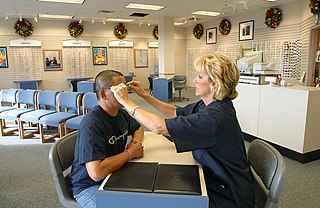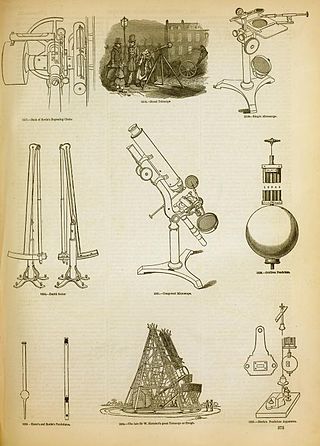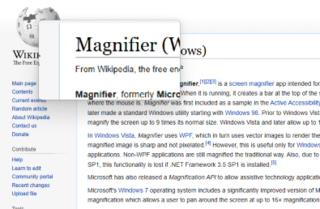
A lens is a transmissive optical device that focuses or disperses a light beam by means of refraction. A simple lens consists of a single piece of transparent material, while a compound lens consists of several simple lenses (elements), usually arranged along a common axis. Lenses are made from materials such as glass or plastic and are ground, polished, or molded to the required shape. A lens can focus light to form an image, unlike a prism, which refracts light without focusing. Devices that similarly focus or disperse waves and radiation other than visible light are also called "lenses", such as microwave lenses, electron lenses, acoustic lenses, or explosive lenses.

A microscope is a laboratory instrument used to examine objects that are too small to be seen by the naked eye. Microscopy is the science of investigating small objects and structures using a microscope. Microscopic means being invisible to the eye unless aided by a microscope.

Optics is the branch of physics that studies the behaviour and properties of light, including its interactions with matter and the construction of instruments that use or detect it. Optics usually describes the behaviour of visible, ultraviolet, and infrared light. Light is a type of electromagnetic radiation, and other forms of electromagnetic radiation such as X-rays, microwaves, and radio waves exhibit similar properties.

A Fresnel lens is a type of composite compact lens which reduces the amount of material required compared to a conventional lens by dividing the lens into a set of concentric annular sections.

Glasses, also known as eyeglasses or spectacles, are vision eyewear with clear or tinted lenses mounted in a frame that holds them in front of a person's eyes, typically utilizing a bridge over the nose and hinged arms, known as temples or temple pieces, that rest over the ears for support.

A dioptre or diopter, symbol dpt or D, is a unit of measurement with dimension of reciprocal length, equivalent to one reciprocal metre, 1 dpt = 1 m−1. It is normally used to express the optical power of a lens or curved mirror, which is a physical quantity equal to the reciprocal of the focal length, expressed in metres. For example, a 3-dioptre lens brings parallel rays of light to focus at 1⁄3 metre. A flat window has an optical power of zero dioptres, as it does not cause light to converge or diverge. Dioptres are also sometimes used for other reciprocals of distance, particularly radii of curvature and the vergence of optical beams.

The optical microscope, also referred to as a light microscope, is a type of microscope that commonly uses visible light and a system of lenses to generate magnified images of small objects. Optical microscopes are the oldest design of microscope and were possibly invented in their present compound form in the 17th century. Basic optical microscopes can be very simple, although many complex designs aim to improve resolution and sample contrast.

Pince-nez is a style of glasses, popular in the late 19th and early 20th centuries, that are supported without earpieces, by pinching the bridge of the nose. The name comes from French pincer, "to pinch", and nez, "nose".

An overhead projector, like a film or slide projector, uses light to project an enlarged image on a screen, allowing the view of a small document or picture to be shared with a large audience.

An optician is an individual who fits glasses or contact lenses by filling a refractive prescription from an optometrist or ophthalmologist. They are able to translate and adapt ophthalmic prescriptions, dispense products, and work with accessories. There are several specialties within the field.

Magnification is the process of enlarging the apparent size, not physical size, of something. This enlargement is quantified by a size ratio called optical magnification. When this number is less than one, it refers to a reduction in size, sometimes called de-magnification.

A magnifying glass is a convex lens that is used to produce a magnified image of an object. The lens is usually mounted in a frame with a handle. Beyond its primary function of magnification, this simple yet ingenious tool serves a variety of purposes. It can be employed to focus sunlight, harnessing the Sun's rays to create a concentrated hot spot at the lens's focus, which is often used for starting fires.

An eyepiece, or ocular lens, is a type of lens that is attached to a variety of optical devices such as telescopes and microscopes. It is named because it is usually the lens that is closest to the eye when someone looks through an optical device to observe an object or sample. The objective lens or mirror collects light from an object or sample and brings it to focus creating an image of the object. The eyepiece is placed near the focal point of the objective to magnify this image to the eyes. The amount of magnification depends on the focal length of the eyepiece.

An optical instrument is a device that processes light waves, either to enhance an image for viewing or to analyze and determine their characteristic properties. Common examples include periscopes, microscopes, telescopes, and cameras.

A lorgnette is a pair of spectacles with a handle, used to hold them in place, rather than fitting over the ears or nose. The word lorgnette is derived from the French lorgner, to take a sidelong look at, and Middle French, from lorgne, squinting. Their precise origin is debated: some sources describe English scientist George Adams the elder as their inventor, while others cite his son George Adams the younger.

A dome magnifier is a dome-shaped magnifying device made of glass or acrylic plastic, used to enlarge words on a page or computer screen. They are plano-convex lenses: the flat (planar) surface is placed on the object to be magnified, and the convex (dome) surface provides the enlargement. They usually provide between 1.8× and 6× magnification. Dome magnifiers are often used by the visually impaired. They are good for reading maps or basic text and their inherent 180° design naturally amplifies illumination from ambient side-light. They are suitable for people with tremors or impaired motor skills, because they are held in contact with the page during use.

Video magnifiers are electronic devices that use a camera and a display screen to perform digital magnification of printed materials. The display screen is usually LCD or a similar flat-screen technology, and the device usually includes a lamp to illuminate the source material. Video magnifiers are designed to be mostly used by people with low vision that cannot be helped using a conventional magnifying glass.

Magnifier, formerly Microsoft Magnifier, is a screen magnifier app intended for visually impaired people to use when running Microsoft Windows. When it is running, it creates a bar at the top of the screen that greatly magnifies where the mouse is. Magnifier was first included as a sample in the Active Accessibility SDK/RDK for Windows 95 and later made a standard Windows utility starting with Windows 98. Prior to Windows Vista, Magnifier could be used to magnify the screen up to 9 times its normal size. Windows Vista and later allow up to 16× magnification.
A microfilm reader is a device used in projecting and magnifying images stored in microform to readable proportions. Microform includes flat film, microfilm, aperture cards, microfiche, and ultra fiche. Using open reels or cassettes, microfilm is often used as a way to store many documents in a small space. It has become increasingly prevalent in the development of films, as well as storage of archived newspapers. With the invention of microfilm, microfilm readers soon developed. With the increasing popularity of computers, microform has decreased in use. However, many library archives still remain in microform.

A sight magnifier is an optical telescope that can be paired with a non-magnifying optical sight on a weapon to create a telescopic sight. They work with the parallel collimated reticle image produced by red dot sights and holographic weapon sights. They may synonymously be referred to as a red dot magnifier, reflex sight magnifier, holographic sight magnifier, or flip to side magnifiers.



















